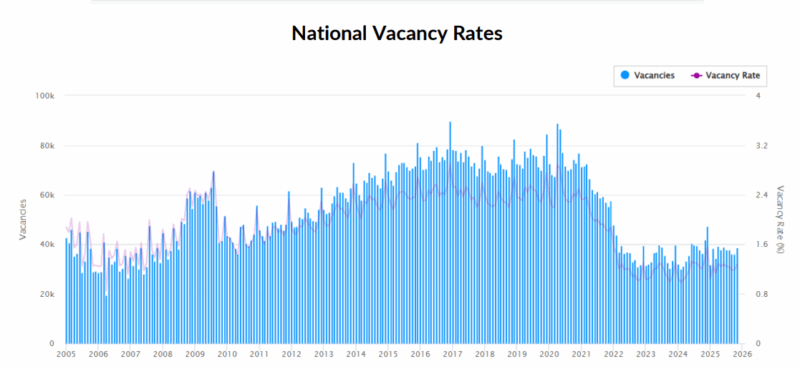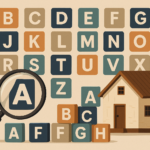
Key takeaways
Australia’s national residential vacancy rate rose to 1.3% in November 2025, up from 1.2% in October.
The total number of residential vacancies increased to 38,690 dwellings, up by 2,538 from the previous month, signalling a mild seasonal easing in the national rental market.
SQM Research released its latest data on residential property vacancy rates.
Australia’s national residential vacancy rate rose to 1.3% in November 2025, up from 1.2% in October.

The total number of residential vacancies increased to 38,690 dwellings, up by 2,538 from the previous month, signalling a mild seasonal easing in the national rental market.
Vacancy Rates - November 2025
| City | Nov 2024 Vacancies | Nov 2024 Vacancy Rate | Oct 2025 Vacancies | Oct 2025 Vacancy Rate | Nov 2025 Vacancies | Nov 2025 Vacancy Rate |
|---|---|---|---|---|---|---|
| Sydney | 13,093 | 1.8% | 9,553 | 1.3% | 10,720 | 1.4% |
| Melbourne | 10,755 | 2.0% | 9,713 | 1.8% | 10,451 | 2.0% |
| Brisbane | 3,918 | 1.1% | 3,391 | 1.0% | 3,645 | 1.0% |
| Perth | 1,162 | 0.6% | 1,304 | 0.7% | 1,311 | 0.7% |
| Adelaide | 1,061 | 0.7% | 1,215 | 0.8% | 1,237 | 0.8% |
| Canberra | 1,034 | 1.7% | 860 | 1.4% | 942 | 1.5% |
| Darwin | 409 | 1.6% | 181 | 0.7% | 250 | 1.0% |
| Hobart | 192 | 0.7% | 107 | 0.4% | 109 | 0.4% |
| National | 41,894 | 1.4% | 36,152 | 1.2% | 38,690 | 1.3% |
Source: SQM Research
Capital city highlights
Sydney:
Vacancy rates rose to 1.4% (from 1.3%), with 10,720 vacancies recorded.
This marks the third consecutive month of modest increases, suggesting an easing from peak rental competition earlier in the year.
Melbourne:
Vacancy rates held steady at 2.0%, with 10,451 dwellings available.
The city continues to maintain a balanced rental market, supported by steady new supply and consistent tenant demand.
Brisbane:
Vacancy rates remained unchanged at 1.0%, with 3,645 vacancies.
The market remains tight, though rent growth has moderated compared to earlier months.
Perth:
Vacancy rates were stable at 0.7%, with 1,311 vacancies.
The city continues to experience one of the lowest vacancy levels nationally amid ongoing undersupply.
Adelaide:
Vacancy rates edged down slightly to 0.8%, with 1,237 dwellings available.
Conditions remain tight, sustaining upward pressure on rents.
Canberra:
Vacancy rates increased to 1.5%, up from 1.4% in October, with 942 vacancies.
The local market typically softens through late spring as turnover slows.
Darwin:
Vacancy rates rose to 1.0% (from 0.7%), with 250 vacancies recorded.
The city has seen a gradual rise in available rentals following earlier shortages.
Hobart:
Vacancy rates remained among the lowest in the country at 0.4%, with 109 dwellings
vacant, reflecting minimal new supply entering the market.
Advertised rents analysis
National advertised rents were largely steady through November, with combined rents unchanged for the month and up 5.3% year-on-year, suggesting that the market is stabilising following sustained rental growth over the past two years.
Sydney:
Combined rents fell 0.1% for the month, though remain 6.3% higher year-on- year, with house rents averaging $885.25 per week.
Melbourne:
Combined rents remained steadfast at 0% for the month and 5% year- on-year, supported by consistent leasing activity across both houses and units.
Brisbane:
Combined rents increased 3% for the month and are up 6.7% annually, with continued strength in detached housing demand.
Perth:
Combined rents rose 1.5% for the month and 5.1% annually, highlighting the city’s persistent shortage of rental listings.
Adelaide:
Combined rents increased 0.6% for the month and 3.3% year-on-year, led by solid growth in both house and unit rents.
Canberra:
Combined rents rose 1.0% for the month and 2.3% annually, following several months of subdued activity.
Darwin:
Combined rents increased 0.5% monthly and 4.4% annually, maintaining its position as one of the stronger performer’s year-on-year.
Hobart:
Combined rents rose 2.5% for the month and 10.9% annually, supported by persistent stock constraints.
Weekly rents index
Sydney
| Property Type | Rent ($) | Weekly change | Monthly change | 12 Months change |
|---|---|---|---|---|
| All Houses | $1,112.26 | -6.26 | -0.6% | 6.8% |
| All Units | $730.39 | -0.39 | 0.4% | 5.8% |
| Combined | $885.25 | -2.79 | -0.1% | 6.3% |
Source: SQM Research
Melbourne
| Property Type | Rent ($) | Weekly change | Monthly change | 12 Months change |
|---|---|---|---|---|
| All Houses | $771.49 | -0.49 | 0.2% | 3.2% |
| All Units | $562.60 | -1.60 | -0.2% | 3.6% |
| Combined | $649.96 | -1.07 | 0.0% | 3.5% |
Source: SQM Research
Brisbane
| Property Type | Rent ($) | Weekly change | Monthly change | 12 Months change |
|---|---|---|---|---|
| All Houses | $777.99 | 0.01 | 0.0% | 7.0% |
| All Units | $618.43 | 1.57 | 0.7% | 6.1% |
| Combined | $706.15 | 0.71 | 0.3% | 6.7% |
Source: SQM Research
Perth
| Property Type | Rent ($) | Weekly change | Monthly change | 12 Months change |
|---|---|---|---|---|
| All Houses | $844.74 | 0.26 | 2.2% | 5.2% |
| All Units | $649.04 | -2.04 | 0.2% | 4.8% |
| Combined | $763.83 | -0.64 | 1.5% | 5.1% |
Source: SQM Research
Adelaide
| Property Type | Rent $) | Weekly change | Monthly change | 12 Months change |
|---|---|---|---|---|
| All Houses | $685.20 | 2.80 | 0.4% | 2.7% |
| All Units | $523.54 | 2.46 | 0.9% | 5.5% |
| Combined | $630.57 | 2.73 | 0.6% | 3.5% |
Source: SQM Research
Canberra
| Property Type | Rent ($) | Weekly change | Monthly change | 12 Months change |
|---|---|---|---|---|
| All Houses | $793.95 | -5.95 | 1.4% | 2.4% |
| All Units | $576.84 | 1.16 | 0.6% | 2.5% |
| Combined | $674.86 | -2.17 | 1.0% | 2.3% |
Source: SQM Research
Darwin
| Property Type | Rent ($) | Weekly change | Monthly change | 12 Months change |
|---|---|---|---|---|
| All Houses | $764.33 | 5.67 | 1.7% | 0.5% |
| All Units | $574.72 | 2.28 | -0.7% | 8.0% |
| Combined | $652.24 | 3.69 | 0.5% | 4.4% |
Source: SQM Research
Hobart
| Property Type | Rent 9$) | Weekly change | Monthly change | 12 Months change |
|---|---|---|---|---|
| All Houses | $601.04 | -1.04 | 1.8% | 11.4% |
| All Units | $508.58 | -1.58 | 3.7% | 9.8% |
| Combined | $564.16 | -1.24 | 2.5% | 10.9% |
Source: SQM Research
National
| Property Type | Rent ($) | Weekly change | Monthly change | 12 Months change |
|---|---|---|---|---|
| All Houses | $743.00 | -5.00 | -0.1% | 5.1% |
| All Units | $582.00 | 2.00 | 1.6% | 5.6% |
| Combined | $668.41 | -1.75 | 0.5% | 5.3% |
Source: SQM Research
Cap City Average
| Property Type | Rent ($) | Weekly change | Monthly change | 12 Months change |
|---|---|---|---|---|
| All Houses | $881.00 | -4.00 | 0.0% | 5.0% |
| All Units | $649.00 | -1.00 | 0.0% | 5.4% |
| Combined | $757.73 | -2.39 | 0.0% | 5.2% |
Source: SQM Research
Commentary
The modest rise in the national vacancy rate to 1.3% reflects a normal seasonal pattern as we head into the end of the year.
Rental markets are still tight overall, but some cities — particularly Sydney — are showing tentative signs of easing.
That said, vacancy rates remain well below long-term averages, especially in Adelaide, Perth, and Hobart, where rental supply continues to fall short of demand.
While rent growth has slowed from its peak, it’s clear that Australia’s housing market remains tight as we go into 2026.
That said, we do expect 2026 overall to be a year of moderation in the rental market.
Indeed we think it is possible 2026 will be the first year since Covid where there is a balance of sorts between new supply and the expansion in underlying demand.
Our forecast from the recent boom and bust report is Australia is likely to complete about 185,000 dwellings which should cater for an additional 480,000 people.
And so, our forecast for capital city rental growth next year is a moderate 2 to 4% which should be in line with inflation.














